『经典背诵短文【18】Modern American Universities』
- 格式:doc
- 大小:36.50 KB
- 文档页数:2
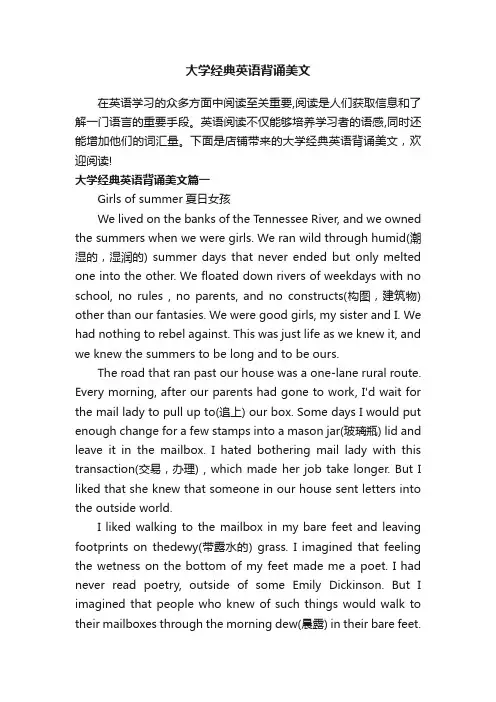
大学经典英语背诵美文在英语学习的众多方面中阅读至关重要,阅读是人们获取信息和了解一门语言的重要手段。
英语阅读不仅能够培养学习者的语感,同时还能增加他们的词汇量。
下面是店铺带来的大学经典英语背诵美文,欢迎阅读!大学经典英语背诵美文篇一Girls of summer夏日女孩We lived on the banks of the Tennessee River, and we owned the summers when we were girls. We ran wild through humid(潮湿的,湿润的) summer days that never ended but only melted one into the other. We floated down rivers of weekdays with no school, no rules , no parents, and no constructs(构图,建筑物) other than our fantasies. We were good girls, my sister and I. We had nothing to rebel against. This was just life as we knew it, and we knew the summers to be long and to be ours.The road that ran past our house was a one-lane rural route. Every morning, after our parents had gone to work, I'd wait for the mail lady to pull up to(追上) our box. Some days I would put enough change for a few stamps into a mason jar(玻璃瓶) lid and leave it in the mailbox. I hated bothering mail lady with this transaction(交易,办理) , which made her job take longer. But I liked that she knew that someone in our house sent letters into the outside world.I liked walking to the mailbox in my bare feet and leaving footprints on thedewy(带露水的) grass. I imagined that feeling the wetness on the bottom of my feet made me a poet. I had never read poetry, outside of some Emily Dickinson. But I imagined that people who knew of such things would walk to their mailboxes through the morning dew(晨露) in their bare feet.We planned our weddings with the help of Barbie dolls and the tiny purple wild flowers growing in our side yard. We became scientists and tested concoctions(调和,混合) of milk, orange juice, and mouthwash(漱口水) . We ate handfuls ofbittersweet(苦乐参半的) chocolate chips and licked peanut butter(花生酱) off spoons. When we ran out of sweets to eat, we snitched sugary Flintstones vitamins out of the medicine cabinet. We became masters of the Kraft macaroni(通心面条) and cheese lunch, and we dutifully called our mother at work three times a day to give her updates on our adventures. But don't call too often or speak too loudly or whine too much, we told ourselves, or else they'll get annoyed and she'll get fired and the summers will end.We shaped our days the way we chose, far from the prying(爱打听的,窥探的)eyes of adults. We found our dad's Playboys and charged the neighborhood boys money to look at them. We made crank(易怒的) calls around the county, telling people they had won a new car. "What kind?" they'd ask. "Red," we'd always say. We put on our mom's old prom(舞会) dresses, complete with gloves and hats, and sang backup to the C.W. McCall song convoy, " which we'd found on our dad's turntable.We went on hikes into the woods behind our house, crawling under barbed wire fences and through tangled undergrowth. Heat and humidity(湿度,湿气) found their way throught he leaves to our flushed faces. We waded in streams that we were always surprised to come across. We walked past cars and auto parts that had beenabandoned(抛弃) in the woods, far from any road. We'd reach the tree line and come out unexpectedly into a cow pasture(牧场,牧草) . We'd perch on the gate or stretch out on the large flat limes(边界,界限) tone outcrop that marked the end of the Woods Behind Our House.One day a thunderstorm blew up along the Tennessee River. It was one of those storms that make the day go dark and the humidity disappear. First it was still and quiet. There was electricity in the air and then the sharp crispness(易碎,酥脆) of a summer day being blown wide open as the winds rushed in. We threw open all the doors and windows. We found the classical radio station from two towns away and turned up the bass and cranked up(把声音调大,启动) the speakers. We let the wind blow in and churn(搅动,搅拌) our summer day around. We let the music we were only vaguely(暧昧地,含糊地) familiar with roar(吼叫,咆哮) through the house. And we twirled(转动,旋转) . We twirled in the living room in the wind and in the music. We twirled and we imagined that we were poets and dancers and scientists and spring brides.We twirled and imagined that if we could let everything --- the thunder, the storm, the wind , the world --- into that house in the banks of the Tennessee River, we could live in our summer dreams forever. When we were girls.大学经典英语背诵美文篇二感悟生活Imagine life as a game in which you are juggling(玩杂耍) some five balls in the air. You name them: Work, Family, Health, Friends, Spirit. And you re keeping all of these in the air. You will soon understand that work is a rubber ball. If you drop it, it will bounce back(反弹) . But the other four balls-family, health, friends and spirit are made of glass. If you drop one of these, they will be irrevocably(不能取消地) scuffed(磨损) , marked, nicked(割进,刻痕) , damaged or even shattered. They will never be the same. You must understand that and strive for balance in your life.How?Don't undermine(破坏,危害) your worth by comparing yourself with others. It is because we are different that each of us is special. Don't set your goals by what other people deem important. Only you know what is best for you. Don't take for granted(认为……理所当然) the things closest to your heart. Cling to them as you would cling to your life, for without them, life is meaningless.Don't let your life slip through your fingers by living in the past or for the future. By living your life one day at a time, you live ALL the days of your life. Don't give up when you still have something to give. Nothing is really over until the moment you stop trying.Don't be afraid to admit that you are less than perfect. It is this fragile thread that binds us each together. Don't be afraid to encounter(遭遇) risks. It is by taking chances that we learn how to be brave. Don't shut love out of your life by saying it's impossible to find. The quickest way to receive love is to give; the fastest way to lose love is to hold it too tightly; and the best way to keep love is to give it wings. Don't run through life so fast that you forget not only where you've been, but also where you are going.把生活想象成一个在空中抛接五只球的游戏。
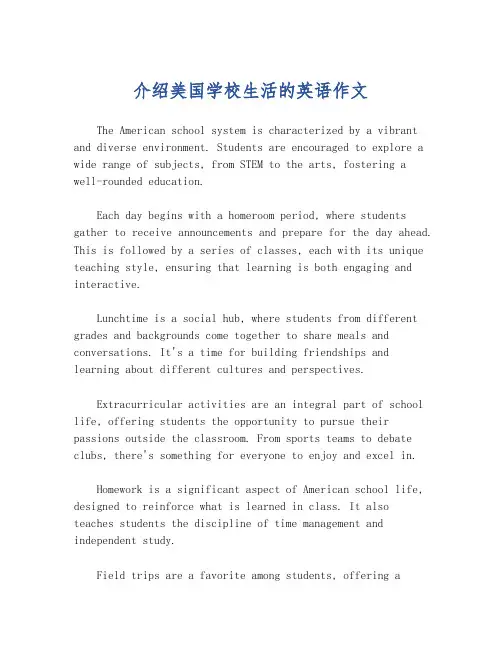
介绍美国学校生活的英语作文The American school system is characterized by a vibrant and diverse environment. Students are encouraged to explore a wide range of subjects, from STEM to the arts, fostering awell-rounded education.Each day begins with a homeroom period, where students gather to receive announcements and prepare for the day ahead. This is followed by a series of classes, each with its unique teaching style, ensuring that learning is both engaging and interactive.Lunchtime is a social hub, where students from different grades and backgrounds come together to share meals and conversations. It's a time for building friendships and learning about different cultures and perspectives.Extracurricular activities are an integral part of school life, offering students the opportunity to pursue their passions outside the classroom. From sports teams to debate clubs, there's something for everyone to enjoy and excel in.Homework is a significant aspect of American school life, designed to reinforce what is learned in class. It also teaches students the discipline of time management and independent study.Field trips are a favorite among students, offering abreak from the usual routine and a chance to learn in a real-world context. These trips are educational and often aligned with the curriculum, making learning a hands-on experience.The school year culminates with a series of exams and projects, which assess students' understanding of the material covered throughout the year. These evaluations are crucial for determining academic progress and setting goals for the future.In essence, American school life is a blend of academic rigor, social interaction, and personal growth, providing students with a comprehensive educational experience that prepares them for the challenges and opportunities of the future.。
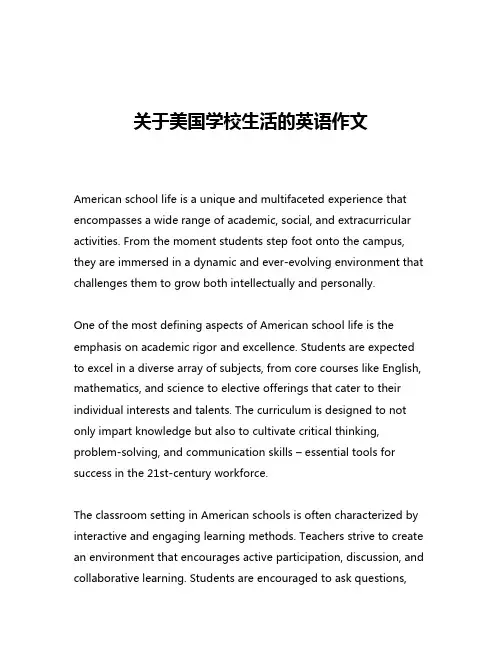
关于美国学校生活的英语作文American school life is a unique and multifaceted experience that encompasses a wide range of academic, social, and extracurricular activities. From the moment students step foot onto the campus, they are immersed in a dynamic and ever-evolving environment that challenges them to grow both intellectually and personally.One of the most defining aspects of American school life is the emphasis on academic rigor and excellence. Students are expected to excel in a diverse array of subjects, from core courses like English, mathematics, and science to elective offerings that cater to their individual interests and talents. The curriculum is designed to not only impart knowledge but also to cultivate critical thinking, problem-solving, and communication skills – essential tools for success in the 21st-century workforce.The classroom setting in American schools is often characterized by interactive and engaging learning methods. Teachers strive to create an environment that encourages active participation, discussion, and collaborative learning. Students are encouraged to ask questions,share their perspectives, and engage in lively debates, fostering a spirit of intellectual curiosity and a love for learning.Beyond the academic realm, American school life also offers a rich tapestry of extracurricular activities. From sports teams and clubs to performing arts and community service organizations, students have ample opportunities to explore their passions, develop new skills, and build meaningful connections with their peers. These extracurricular pursuits not only provide a outlet for personal growth but also teach valuable lessons about teamwork, leadership, and time management.One of the most distinctive features of American school life is the emphasis on school spirit and community. Students take great pride in their school and actively participate in various school-wide events, such as homecoming celebrations, pep rallies, and school dances. These events not only foster a sense of belonging and camaraderie among students but also serve as a platform for them to showcase their talents and celebrate their school's achievements.The social aspect of American school life is equally important, as students navigate the complexities of navigating new relationships, making friends, and learning to navigate the social dynamics of their peer groups. Schools often provide guidance and support through counseling services, mentorship programs, and student clubs thataddress the unique challenges and concerns of adolescents.One of the most significant advantages of American school life is the diversity of the student population. Schools in the United States are often microcosms of the larger society, with students from a wide range of cultural, socioeconomic, and ethnic backgrounds. This diversity not only enriches the learning experience but also teaches students the valuable lessons of tolerance, empathy, and respect for different perspectives.However, American school life is not without its challenges. Issues such as bullying, academic stress, and mental health concerns have become increasingly prevalent in recent years, requiring schools to implement comprehensive support systems and intervention strategies. Educators and administrators work tirelessly to create safe, inclusive, and nurturing environments that address the holistic needs of their students.Despite these challenges, the overall experience of American school life remains a transformative journey that shapes the lives of countless young individuals. From the rigorous academic curriculum to the vibrant extracurricular landscape, American schools provide students with the tools and opportunities to develop into well-rounded, confident, and socially conscious adults.As students navigate the complexities of American school life, they learn valuable lessons about perseverance, resilience, and the power of community. They emerge from this experience not only with a strong academic foundation but also with a deeper understanding of themselves, their peers, and the world around them.In conclusion, American school life is a multifaceted and dynamic experience that encompasses a wide range of academic, social, and extracurricular activities. It is a journey of growth, discovery, and personal transformation that prepares students for the challenges and opportunities that lie ahead in their future endeavors.。
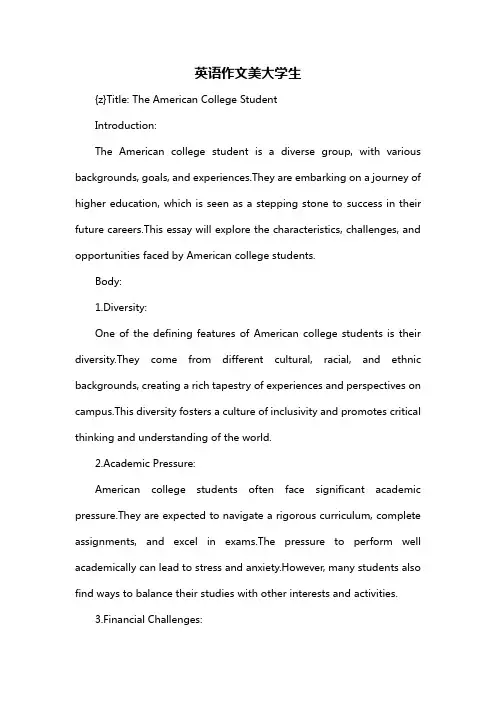
英语作文美大学生{z}Title: The American College StudentIntroduction:The American college student is a diverse group, with various backgrounds, goals, and experiences.They are embarking on a journey of higher education, which is seen as a stepping stone to success in their future careers.This essay will explore the characteristics, challenges, and opportunities faced by American college students.Body:1.Diversity:One of the defining features of American college students is their diversity.They come from different cultural, racial, and ethnic backgrounds, creating a rich tapestry of experiences and perspectives on campus.This diversity fosters a culture of inclusivity and promotes critical thinking and understanding of the world.2.Academic Pressure:American college students often face significant academic pressure.They are expected to navigate a rigorous curriculum, complete assignments, and excel in exams.The pressure to perform well academically can lead to stress and anxiety.However, many students also find ways to balance their studies with other interests and activities.3.Financial Challenges:The rising cost of tuition and fees poses a significant challenge for many American college students.Many students rely on loans, scholarships, or part-time jobs to finance their education.This financial strain can impact their mental health and overall well-being.Efforts are being made to address this issue through financial aid, scholarships, and increased access to affordable education options.4.Campus Life:Campus life is an essential part of the American college experience.Students live in dormitories, participate in extracurricular activities, and engage in social events.This environment encourages personal growth, leadership development, and the formation of lifelong friendships.Campus life also provides opportunities for students to explore their interests and passions outside of the classroom.5.Career Preparation:American college students are often focused on preparing for their future careers.They participate in internships, co-operative education programs, and networking events to gain practical experience and build their professional skills.Many students also seek guidance from career services departments on campus to help them navigate their career paths and make informed decisions about their futures.Conclusion:The American college student is a multifaceted individual, facingchallenges and opportunities as they pursue their education.Their diversity, academic pressure, financial constraints, campus life, and career preparation all contribute to their unique college experience.Despite the challenges, American college students continue to strive for success, fostering a culture of growth, innovation, and inclusivity.。

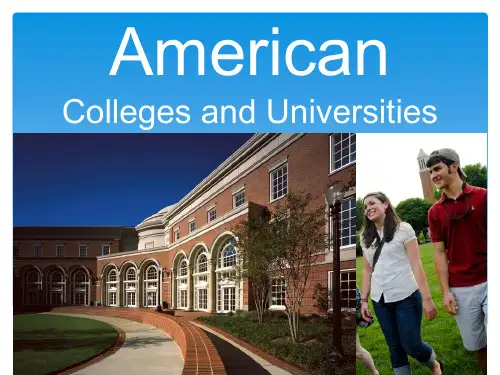
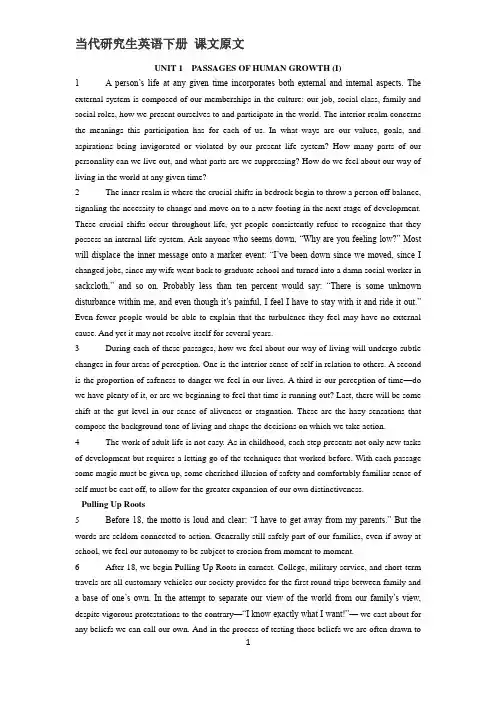
UNIT 1 PASSAGES OF HUMAN GROWTH (I)1 A person’s life at any given time incorporates both external and internal aspects. The external system is composed of our memberships in the culture: our job, social class, family and social roles, how we present ourselves to and participate in the world. The interior realm concerns the meanings this participation has for each of us. In what ways are our values, goals, and aspirations being invigorated or violated by our present life system? How many parts of our personality can we live out, and what parts are we suppressing? How do we feel about our way of living in the world at any given time?2 The inner realm is where the crucial shifts in bedrock begin to throw a person off balance, signaling the necessity to change and move on to a new footing in the next stage of development. These crucial shifts occur throughout life, yet people consistently refuse to recognize that they possess an internal life system. Ask anyone who seems down, “Why are you feeling low?” Most will displace the inner message onto a marker event: “I’ve been down since we moved, since I changed jobs, since my wife went back to graduate school and turned into a damn social worker in sackcloth,” and so on. Probably less than ten percent would say: “There is some unknown disturbance within me, and even though it’s painful, I feel I have to stay with it and ride it out.” Even fewer people would be able to explain that the turbulence they feel may have no external cause. And yet it may not resolve itself for several years.3 During each of these passages, how we feel about our way of living will undergo subtle changes in four areas of perception. One is the interior sense of self in relation to others. A second is the proportion of safeness to danger we feel in our lives. A third is our perception of time—do we have plenty of it, or are we beginning to feel that time is running out? Last, there will be some shift at the gut level in our sense of aliveness or stagnation. These are the hazy sensations that compose the background tone of living and shape the decisions on which we take action.4 The work of adult life is not easy. As in childhood, each step presents not only new tasks of development but requires a letting go of the techniques that worked before. With each passage some magic must be given up, some cherished illusion of safety and comfortably familiar sense of self must be cast off, to allow for the greater expansion of our own distinctiveness.Pulling Up Roots5 Before 18, the motto is loud and clear: “I have to get away from my parents.” But the words are seldom connected to action. Generally still safely part of our families, even if away at school, we feel our autonomy to be subject to erosion from moment to moment.6 After 18, we begin Pulling Up Roots in earnest. College, military service, and short-term travels are all customary vehicles our society provides for the first round trips between family and a base of one’s own. In the attempt to separate our view of the world from our family’s view, despite vigorous protestations to the contrary—“I know exactly what I want!”— we cast about for any beliefs we can call our own. And in the process of testing those beliefs we are often drawn to1fads, preferably those most mysterious and inaccessible to our parents.7 Whatever tentative memberships we try out in the world, the fear haunts us that we are really kids who cannot take care of ourselves. We cover that fear with acts of defiance and mimicked confidence. For allies to replace our parents, we turn to our contemporaries. They become conspirators. So long as their perspective meshes with our own, they are able to substitute fo r the sanctuary of the family. But that doesn’t last very long. And the instan t they diverge from the shaky ideals of “our group”, they are seen as betrayers. Rebounds to the family are common between the ages of 18 and 22.8 The tasks of this passage are to locate ourselves in a peer group role, a sex role, an anticipated occupation, an ideology or world view. As a result, we gather the impetus to leave home physically and the identity to begin leaving home emotionally.9 Even as one part of us seeks to be an individual, another part longs to restore the safety and comfort of merging with another. Thus one of the most popular myths of this passage is: We can piggyback our development by attaching to a Stronger One. But people who marry during this time often prolong financial and emotional ties to the family and relatives that impede them from becoming self-sufficient.10 A stormy passage through the Pulling Up Roots years will probably facilitate the normal progression of the adult life cycle. If one doesn’t have an identity crisis at this point, it will erupt during a later transition, when the penalties may be harder to bear.The Trying Twenties11 The Trying Twenties confront us with the question of how to take hold in the adult world. Our focus shifts from the interior turmoils of late adolescence—“Who am I?”“What is truth?”—and we become almost totally preoccupied with working out the externals. “How do I put my aspirations into effect?” “What is the best way to start?” “Where do I go?” “Who can help me?” “How did you do it?”12 In this period, which is longer and more stable compared with the passage that leads to it, the tasks are as enormous as they are exhilarating: To shape a Dream, that vision of ourselves which will generate energy, aliveness, and hope. To prepare for a lifework. To find a mentor if possible. And to form the capacity for intimacy, without losing in the process whatever consistency of self we have thus far mustered. The first test structure must be erected around the life we choose to try.13 Doing what we “should” is the most pervasive theme of the twenties. The “shoulds” are largely defined by family models, the press of the culture, or the prejudices of our peers. If the prevailing cultural instructions are that one should get married and settle down behind one’s own door, a nuclear family is born.14 One of the terrifying aspects of the twenties is the inner conviction that the choices we make are irrevocable. It is largely a false fear. Change is quite possible, and some alteration of ouroriginal choices is probably inevitable.15 Two impulses, as always, are at work. One is to build a firm, safe structure for the future by making strong commitments, to “be set”. Yet people who slip into a ready-made form without much self-examination are likely to find themselves locked in.16 The other urge is to explore and experiment, keeping any structure tentative and therefore easily reversible. Taken to the extreme, these are people who skip from one trial job and one limited personal encounter to another, spending their twenties in the transient state.17 Although the choices of our twenties are not irrevocable, they do set in motion a Life Pattern. Some of us follow the locked-in pattern, others the transient pattern, the wunderkind pattern, the caregiver pattern, and there are a number of others. Such patterns strongly influence the particular questions raised for each person during each passage through the life.18 Buoyed by powerful illusions and belief in the power of the will, we commonly insist in our twenties that what we have chosen to do is the one true course in life. Our backs go up at the merest hint that we are like our parents, that two decades of parental training might be reflected in our current actions and attitudes.19 “Not me,” is the motto, “I’m different.”UNIT 2 AIDS IN THE THIRD WORLD A GLOBAL DISASTER1 In rich countries AIDS is no longer a death sentence. Expensive drugs keep HIV-positive patients alive and healthy, perhaps indefinitely. Loud public-awareness campaigns keep the number of infected Americans, Japanese and West Europeans to relatively low levels. The sense of crisis is past.2 In developing countries, by contrast, the disease is spreading like nerve gas in a gentle breeze. The poor cannot afford to spend $10,000 a year on wonder pills. Millions of Africans are dying. In the longer term, even greater numbers of Asians are at risk. For many poor countries, there is no greater or more immediate threat to public health and economic growth. Yet few political leaders treat it as a priority.3 Since HIV was first identified in the 1970s, over 47 million people have been infected, of whom 14 million have died. Last year saw the biggest annual death toll yet: 2.5 million. The disease now ranks fourth among the wor ld’s big killers, after respiratory infections, diarrhea disorders and tuberculosis. It now claims many more lives each year than malaria, a growing menace, and is still nowhere near its peak. If India and other Asian countries do not take it seriously, th e number of infections could reach “a new order of magnitude”, says Peter Piot, head of the UN’s AIDS programme.4 The human immunodeficiency virus (HIV), which causes acquired immune deficiency syndrome (AIDS), is thought to have crossed from chimpanzees to humans in the late 1940s or early 1950s in Congo. It took several years for the virus to break out of Congo’s dense and sparsely populated jungles but, once it did, it marched with rebel armies through the continent’s3numerous war zones, rode with truckers from one rest-stop brothel to the next, and eventually flew, perhaps with an air steward, to America, where it was discovered in the early 1980s. As American homosexuals and drug infectors started to wake up to the dangers of bath-houses andneedle-sharing, AIDS was already devastating Africa.5 So far, the worst-hit areas are east and southern Africa. In Botswana, Namibia, Swaziland and Zimbabwe, between a fifth and a quarter of people aged 15-49 are afflicted with HIV or AIDS. In Botswana, children born early in the next decade will have a life expectancy of 40; without AIDS it would have been near 70. Of the 25 monitoring sites in Zimbabwe where pregnant women are tested for HIV, only two in 1997 showed prevalence below 10%. At the remaining 23 sites,20-50% of women were infected. About a third of these women will pass the virus on to their babies.6 The region’s giant, South Africa, was largely protected by its isolation from the rest of the world during the apartheid years. Now it is host to one in ten of the world’s new infections—more than any other country. In the country’s most populous province, KwaZulu-Natal, perhaps a third of sexually active adults are HIV-positive.7 Asia is the next disaster-in-waiting. Already, 7 million Asians a re infected. India’s 930 million people look increasingly vulnerable. The Indian countryside, which most people imagined relatively AIDS-free, turns out not to be. A recent study in Tamil Nadu found over 2% of rural people to be HIV-positive: 500,000 peopl e in one of India’s smallest states. Since 10% had other sexually transmitted diseases (STDS), the avenue for further infections is clearly open. A survey of female STD patients in Poona, in Maharashtra, found that over 90% had never had sex with anyone but their husband; and yet 13.6% had HIV.8 No one knows what AIDS will do to poor countries’ economies, for nowhere has the epidemic run its course. An optimistic assessment, by Alan Whiteside of the University of Natal, suggests that the effect of AIDS on measurable GDP will be slight. Even at high prevalence, Mr. Whiteside thinks it will slow growth by no more than 0.6% a year. This is because so many people in poor countries do not contribute much to the formal economy. To put it even more crudely, where there is a huge oversupply of unskilled labour, the dead can easily be replaced.9 Other researchers are more pessimistic. AIDS takes longer to kill than did the plague, so the cost of caring for the sick will be more crippling. Modern governments, unlike medieval ones, tax the healthy to help look after the ailing, so the burden will fall on everyone. And AIDS, because it is sexually transmitted, tends to hit the most energetic and productive members of society. A recent study in Namibia estimated that AIDS cost the country almost 8% of GNP in 1996. Another analysis predicts that Kenya’s GDP will be 14.5% smaller in 2005 than it would have been without AIDS, and that income per person will be 10% lower.The cost of the disease10 In general, the more advanced the economy, the worse it will be affected by a large numberof AIDS deaths. South Africa, with its advanced industries, already suffers a shortage of skilled manpower, and cannot afford to lose more. In better-off developing countries, people have more savings to fall back on when they need to pay medical bills. Where people have health and life insurance, those industries will be hit by bigger claims. Insurers protect themselves by charging more or refusing policies to HIV-positive customers. In Zimbabwe, life-insurance premiums quadrupled in two years because of AIDS. Higher premiums force more people to seek treatment in public hospitals: in South Africa, HIV and AIDS could account for between 35% and 84% of public-health expenditure by 2005, according to one projection.11 At a macro level, the impact of AIDS is felt gradually. But at a household level, the blow is sudden and catastrophic. When a breadwinner develops AIDS, his (or her) family is impoverished twice over: his income vanishes, and his relations must devote time and money to nursing him. Daughters are often forced to drop out of school to help. Worse, HIV tends not to strike just one member of a family. Husbands give it to wives, mothers to babies.12 The best hope for halting the epidemic is a cheap vaccine. Efforts are under way, but a vaccine for a virus that mutates as rapidly as HIV will be hugely difficult and expensive to invent. For poor countries, the only practical course is to concentrate on prevention. But this, too, will be hard, for a plethora of reasons.Sex is fun... Many feel that condoms make it less so. Zimbabweans ask: “Would you eat a sweet with its wrapper on?”... and discussion of it is often taboo. In Kenya, Christian and Islamic groups have publicly burned anti-AIDS leaflets and condoms, as a protest against what they see as the encouragement of promiscuity.Poverty. Those who cannot afford television find other ways of passing the evening. People cannot afford antibiotics, so the untreated sores from STDS provide easy openings for HIV.Migrant labour. Since wages are much higher in South Africa than in the surrounding region, outsiders flock in to find work. Migrant miners (including South Africans forced to live far from their homes) spend most of the year in single-sex dormitories surrounded by prostitutes. Living with a one-in-40 chance of being killed by a rockfall, they are inured to risk. When they go home, they often infect their wives.War. Refugees, whether from genocide in Rwanda or state persecution in Myanmar, spread HIV as they flee. Soldiers, with their regular pay and disdain for risk, are more likely than civilians to contract HIV from prostitutes. When they go to war, they infect others. In Africa the problem is dire. In Congo, where no fewer than seven armies are embroiled, the government has accused Ugandan troops (which are helping the Congolese rebels) of deliberately spreading AIDS. Unlikely, but with estimated HIV prevalence in the seven armies ranging from 50% for the Angolans to an incredible 80% for the Zimbabweans, the effect is much the same. Sexism. In most poor countries, it is hard for a woman to ask her partner to use a condom. Wives who insist risk5being beaten up. Rape is common, especially where wars rage. Forced sex is a particularly effective means of HIV transmission, because of the extra blood. Drinking. Asia and Africa make many excellent beers. They are also home to a lot of people for whom alcohol is the quickest escape from the stresses of acute poverty. Drunken lovers are less likely to remember to use condoms.How to fight the virus13 Pessimists look at that situation and despair. But three success stories show that the hurdles to prevention are not impossibly high.14 First, Thailand. One secret of T hailand’s success has been timely, accurateinformation-gathering. HIV was first detected in Thailand in the mid-1980s, among male homosexuals. The health ministry immediately began to monitor other high-risk groups, particularly the country’s many heroin addicts and prostitutes. In the first half of 1988, HIV prevalence among drug injectors tested at one Bangkok hospital leapt from 1% to 30%. Shortly afterwards, infections soared among prostitutes.15 The response was swift. A survey of Thai sexual behaviour was conducted. The results, which showed men indulging in a phenomenal amount of unprotected commercial sex, were publicized. Thais were warned that a major epidemic would strike if their habits did not change. A “100% condom use” campaign persuaded prostitutes to insist on protection 90% of the time with non-regular customers.16 Most striking was the government’s success in persuading people that they were at risk long before they started to see acquaintances die from AIDS. There was no attempt to play down the spread of HIV to avoid scaring off tourists, as happened in Kenya. Thais were repeatedly warned of the dangers, told how to avoid them, and left to make their own choices. Most decided that a long life was preferable to a fast one.17 Second, Uganda. Thailand shows what is possible in a well-educated, fairly prosperous country. Uganda shows that there is hope even for countries that are poor and barely literate. President Yoweri Museveni recognized the threat shortly after becoming president in 1986, and deluged the country with anti-AIDS warnings.18 The key to Uganda’s success is twofold. First, Mr. Museveni made every government department take the problem seriously, and implement its own plan to fight the virus. Accurate surveys of sexual behaviour were done for only $20,000-30,000 each. Second, he recognized that his government could do only a limited amount, so he gave free rein to scores ofnon-governmental organizations (NGOS), usually foreign-financed, to do whatever it took to educate people about risky sex.19 Third, Senegal. If Uganda shows how a poor country can reverse the track of an epidemic, Senegal shows how to stop it from taking off in the first place. This West African country was fortunate to be several thousand mil es from HIV’s origin. In the mid-1980s, when other parts ofAfrica were already blighted, Senegal was still relatively AIDS-free. In concert withnon-governmental organizations and the press and broadcasters, the government set up a national AIDS-control programme to keep it that way.20 Contrast these three with South Africa. On December 1st, World AIDS Day, President Nelson Mandela told the people of KwaZulu-Natal that HIV would devastate their communities if not checked. The speech was remarkable not for its quality—Mr. Mandela is always able to move audiences—but for its rarity. Unlike Mr. Museveni, South Africa’s leader seldom uses his authority to encourage safer sex. It is a tragic omission. Whereas the potholed streets of Kampala are lined with signs promoting fidelity and condoms, this correspondent has, in eight months in South Africa, seen only two anti-AIDS posters, both in the UN’s AIDS office in Pretoria.UNIT 3 NEW FINDINGS OF HIV1 For almost four years, research into HIV has been dominated by a single theory about how the virus causes the catastrophic collapse of the immune defences that leads to AIDS. But the consensus on this theory is now crumbling, thanks in part to the work of a Dutch team led by immunologist Frank Miedema. If the Dutch team is right, the consequences will be profound. People with HIV may hope for new types of treatment. And some of the most cherished dogmas ofa multibillion-dollar research industry may be overturned.2 The prevailing view about how HIV causes AIDS is that every day the virus makes billions of copies of itself and, in doing so, kills billions of the key defence cells that it infects, a class of T cell known as CD4 cells. These vital cells orchestrate the body’s immune response. Every day the infected person’s immune system attempts to replace these cells. After years of waging this immunological war, the body eventually fails to keep pace with the virus and the numbers of CD4 cells become dangerously low, leaving the body unable to defend itself against microorganisms and cancerous cells.3 But Miedema and his colleagues at the University of Amsterdam see things differently. They agree that the number of CD4 cells ultimately dwindles, but not because the virus is killing them off. In t heir view, the virus impairs the body’s ability to produce new CD4 cells, and—critically—it traps existing cells in lymph nodes and other tissues, preventing their movement in and out of the bloodstream. As large numbers of CD4 cells become trapped in this way, and the body fails to produce a sufficient number of new ones, the dwindling population of circulating cells becomes increasingly restricted in its range and ability to respond to different invading microbes.4 Naturally, the champions of the prevailing theory dispute the Dutch ideas. David Ho, chief architect and proponent of the accepted view, at the Aaron Diamond AIDS Research Center in New York, has told colleagues that “the whole field would have to be turned upside down if they were right”. But elsewhere, the controversial Dutch theory is gaining ground. Indeed, it builds on ideas that have been circulating since about 1990, among researchers such as Yvonne Rosenberg at7TherImmune, a company in Maryland, and John Sprent, at the University of California, San Diego. Earlier this month, Miedema’s latest findings were aired at a major international meeting in Glasgow on new therapies for HIV—a sign that the ideas are attracting interest from those at the sharp end of AIDS treatment.5 The widely accepted view, that HIV is a mass murderer of cells, first took hold in 1995, when Ho and his colleagues in New York, and another group led by George Shaw of the University of Alabama at Birmingham, published two seminal papers in the journal Nature. These papers reported that there was a large and rapid turnover of CD4 cells in people with HIV infection, and that therapy with a powerful cocktail of antiviral drugs brought about huge and immediate increases in the numbers of these cells. The fact that the cells bounced back so quickly was due, Ho and Shaw reasoned, to the effects of the antiviral drugs. By stopping HIV from building new copies of itself, the drugs stopped the virus from killing (or “lysing”)cells, while new cells continued to be produced at a rapid rate. This compelling idea offered a simple explanation for how HIV could wreak such havoc. Overnight, the theory became dogma.6 Then, in November 1996, Miedema proposed an alternative view. His work at that time centred on telomeres. These are the small sections of DNA at each end of a chromosome that are shortened with each cycle of cell division. Miedema and his colleagues reasoned that if CD4 cells were being constantly destroyed, then the unremitting cell division needed to supply the new cells would wear away their telomeres.7 Yet the length of the telomeres turned out to be stable. “This means that cells are not being turned over in massive numbers,” Miedema said at the time. “Our data cannot be interpreted any other way.” He sugges ted that if the cells are disappearing but not being destroyed, then HIV must be hitting their production instead.8 Ho disagreed. He said that an enzyme called telomerase, which rebuilds telomeres in cells that need to carry on dividing indefinitely, such as reproductive cells, is overactive in people with HIV. The enzyme is active in their immune cells, where normally it is absent. He argued that this overactivity could explain why the telomeres do not shorten. But Miedema’s group has tested T cells from people with HIV and has found no evidence of increased telomerase activity. Ho retorts that their tests are not sufficiently sensitive, and that special assays are needed.9 Ho’s views find support from Tomas Lindahl, a telomere specialist at Britain’s Imperial Cancer Research Fund. “I don’t think the telomere argument... is very strong,” he says. “Telomerase activity is notoriously difficult to measure.”10 Indeed, other researchers now suggest that Miedema may have misinterpreted his original results. They believe that he found the average length of telomeres to be stable because he missed those cells that were disappearing most rapidly—the very cells that would have the shortest telomeres if they were turning over at the rate Ho suggests.11 Whether the telomere research is significant or not, a growing number of researchers nowbelieve that HIV does prevent the production of new T cells. Mike McCune at the University of California, San Francisco, suggests that the site of this inhibition could be the thymus, the organ where CD4 cells develop. But the Dutch group and others were increasingly convinced that there was another possibility. If T cells were disappearing from the blood, perhaps it was not just because new cells were failing to appear. It could also be that existing cells were being hidden away in other tissues. Miedema and his colleagues were puzzled by the flood of CD4 cells rushing into the blood that Ho and others had observed when infected people start to take antiviral drugs. They knew that the rise was rapid and then reached a plateau, and so they argued that it could not be due to the production of new cells because this would lead to a slow, more sustained increase. Instead, it must be due to the release of existing CD4 cells trapped in lymph nodes and elsewhere.12 Their own experiments supported their hunch. When they analysed T cells in the blood of people with HIV as they started antiviral treatment, they found the same steep rise of CD4 cells, reaching a plateau within three weeks. The findings also appear to explain a phenomenon that has puzzled doctors, namely that the more advanced a person’s HIV infection, the greater the initial rise in their CD4 cell count when they start antiviral therapy. This, says Miedema, is because more and more cells become trapped as infection persists. If Ho and Shaw were right, the increase in CD4 cells should be modest in such people, because the virus would have killed so many of their cells.13 But the nature of the newly appeared cells gave the Dutch team further support. They were virtually all so-called CD4 memory cells——that is, cells that had already come into contact with antigens from specific invading microbes. What is more, so-called naive CD4 cells——those that have not yet met an antigen—did not immediately appear. These findings strengthen the argument that antiviral drugs were not preventing HIV from killing cells, but simply releasing into the blood mature CD4 cells that had been trapped elsewhere.14 An obvious response to the suggestion that CD4 cells are disappearing from blood into lymph tissue might be: “ Why not count them?” Unfortunately, this is easier said than done. Removinglymph tissue is awkward and unpleasant—and may be unhelpful to patients whose immune systems are already disrupted. Equally important, researchers would not know exactly how many CD4 cells a patient had in the first place, and therefore would have no baseline figure with which to compare their estimate. Finally, even in healthy individuals, the number of CD4 cells in the bloodstream is a tiny proportion—between 1 and 2 per cent—of the total. So even if the researchers measured their decline in the bloodstream and estimated their numbers in the lymph nodes over a period of time, the margin of error would probably be too wide for the counts to be meaningful.15 The Dutch group now has the backing of a growing number of immunologists. Brigitte Autran at the Pitié-Salpetrière Hospital in Paris has found that, in people with HIV who take powerful drug cocktails, the immune system appears to be able to take a break from the damaging9。
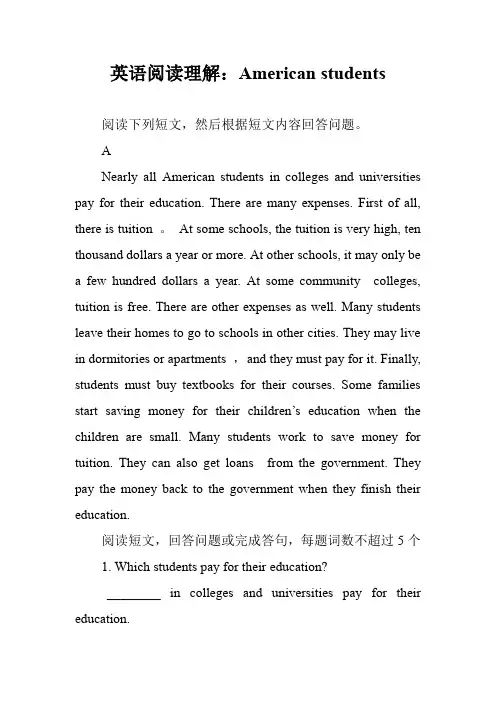
英语阅读理解:American students阅读下列短文,然后根据短文内容回答问题。
ANearly all American students in colleges and universities pay for their education. There are many expenses. First of all, there is tuition 。
At some schools, the tuition is very high, ten thousand dollars a year or more. At other schools, it may only be a few hundred dollars a year. At some community colleges, tuition is free. There are other expenses as well. Many students leave their homes to go to schools in other cities. They may live in dormitories or apartments ,and they must pay for it. Finally, students must buy textbooks for their courses. Some families start saving money for their children’s education when the children are small. Many students work to save money for tuition. They can also get loans from the government. They pay the money back to the government when they finish their education.阅读短文,回答问题或完成答句,每题词数不超过5个1. Which students pay for their education?________ in colleges and universities pay for their education.2. How much is the higher tuition?It is _______________ or more.3. Are there any free tuition colleges?___________________________.do many students live in dormitories or apartments?Because they_______________.5. What must students buy finally?They must _______________.6. When do many students pay back their loans from the government?They pay them back_______________.【参考答案】A篇【文章大意】几乎所有的美国大学生都要支付教育费用。
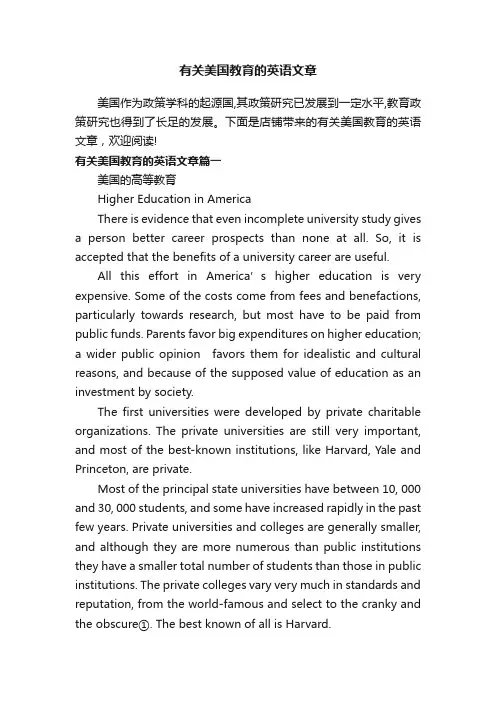
有关美国教育的英语文章美国作为政策学科的起源国,其政策研究已发展到一定水平,教育政策研究也得到了长足的发展。
下面是店铺带来的有关美国教育的英语文章,欢迎阅读!有关美国教育的英语文章篇一美国的高等教育Higher Education in AmericaThere is evidence that even incomplete university study gives a person better career prospects than none at all. So, it is accepted that the benefits of a university career are useful.All this effort in America’s higher education is very expensive. Some of the costs come from fees and benefactions, particularly towards research, but most have to be paid from public funds. Parents favor big expenditures on higher education;a wider public opinion favors them for idealistic and cultural reasons, and because of the supposed value of education as an investment by society.The first universities were developed by private charitable organizations. The private universities are still very important, and most of the best-known institutions, like Harvard, Yale and Princeton, are private.Most of the principal state universities have between 10, 000 and 30, 000 students, and some have increased rapidly in the past few years. Private universities and colleges are generally smaller, and although they are more numerous than public institutions they have a smaller total number of students than those in public institutions. The private colleges vary very much in standards and reputation, from the world-famous and select to the cranky and the obscure①. The best known of all is Harvard.There are also many junior colleges to which students may be admitted at the end of their high school career, providing only the first two years of university work.For the most part Americans think that there’s some advantage in attending one of the better-known private institutions, in spite of the higher cost, rather than a state university. However, testate universities are becoming increasingly important, and some of them, particularly in the Midwest have a reputation practically equal to that of the private ones. Almost every state by now has several university institutions directly under the authority of the state government. 有关美国教育的英语文章篇二美国年轻人看的励志文章If you're one in a million in China, there are 1300 people just like you.在中国,如果你是百万取一的精英,那么仍有1300个和你势均力敌的竞争者。
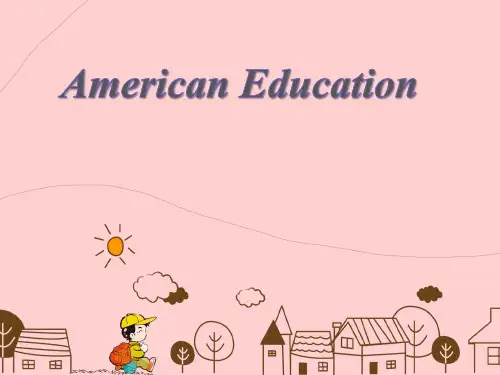
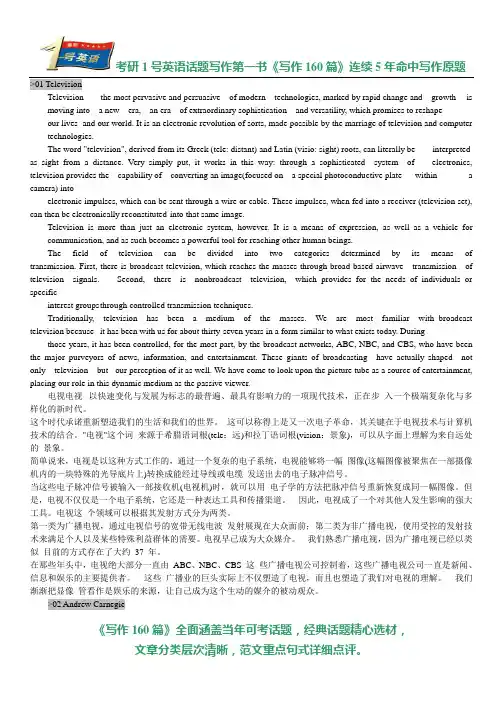
《写作160篇》全面涵盖当年可考话题,经典话题精心选材,Television -- the most pervasive and persuasive of modern technologies, marked by rapid change and growth -- is moving into a new era, an era of extraordinary sophistication and versatility, which promises to reshape our lives and our world. It is an electronic revolution of sorts, made possible by the marriage of television and computer technologies.The word "television", derived from its Greek (tele: distant) and Latin (visio: sight) roots, can literally be interpreted as sight from a distance. Very simply put, it works in this way: through a sophisticated system of electronics, television provides the capability of converting an image(focused on a special photoconductive plate within a camera) intoelectronic impulses, which can be sent through a wire or cable. These impulses, when fed into a receiver (television set), can then be electronically reconstituted into that same image.Television is more than just an electronic system, however. It is a means of expression, as well as a vehicle for communication, and as such becomes a powerful tool for reaching other human beings.The field of television can be divided into two categories determined by its means of transmission. First, there is broadcast television, which reaches the masses through broad-based airwave transmission of television signals. Second, there is nonbroadcast television, which provides for the needs of individuals or specificinterest groups t hrough controlled transmission techniques.Traditionally, television has been a medium of the masses. We are most familiar with broadcast television because it has been with us for about thirty-seven years in a form similar to what exists today. Duringthose years, it has been controlled, for the most part, by the broadcast networks, ABC, NBC, and CBS, who have been the major purveyors of news, information, and entertainment. These giants of broadcasting have actually shaped not only television but our perception of it as well. We have come to look upon the picture tube as a source of entertainment, placing our role in this dynamic medium as the passive viewer.电视电视--以快速变化与发展为标志的最普遍、最具有影响力的一项现代技术,正在步 入一个极端复杂化与多样化的新时代。
美国读大学英语作文In recent years, studying in the United States has become an increasingly popular choice for many students around the world. The United States is renowned for itstop-tier universities, diverse cultural experiences, and excellent educational systems. As a result, more and more students are choosing to pursue their higher education in the United States. In this essay, I will discuss the reasons why studying in the United States is highly sought after and the benefits it offers to international students.Firstly, the United States is home to some of theworld's most prestigious universities. Institutions such as Harvard, Stanford, and MIT consistently rank among the top universities globally. These universities are known for their rigorous academic programs, renowned faculty members, and cutting-edge research opportunities. By studying in the United States, students have the chance to learn from some of the brightest minds in their respective fields, which can greatly enhance their academic knowledge and skills.Secondly, studying in the United States provides international students with a multicultural and diverse environment. The United States is a melting pot of cultures, with people from various backgrounds and nationalities.This diversity fosters a rich and vibrant learning experience, allowing students to broaden their horizons, gain a global perspective, and develop a deeper understanding of different cultures. Interacting with students from around the world not only enhances one'ssocial skills but also promotes tolerance and acceptance.Moreover, the United States offers a wide range of programs and majors for students to choose from. Whether it is engineering, business, arts, or sciences, American universities provide a plethora of options for students to pursue their academic interests. This flexibility allows students to tailor their education to their individualgoals and aspirations. Additionally, American universities often emphasize a holistic approach to education, encouraging students to explore various disciplines and engage in extracurricular activities. This well-roundededucation prepares students for the challenges of the real world and equips them with the skills necessary for success in their future careers.Furthermore, studying in the United States provides numerous opportunities for personal and professional growth. Many American universities have strong ties to industries and businesses, offering students internships, co-op programs, and networking opportunities. These experiences allow students to gain practical skills, build professional connections, and increase their employability upon graduation. The United States also has a thriving startup culture, with Silicon Valley being a hub for innovation and entrepreneurship. By studying in the United States,students have the chance to immerse themselves in this entrepreneurial ecosystem and potentially launch their own ventures.In conclusion, studying in the United States offers numerous advantages for international students. Thecountry's prestigious universities, diverse cultural experiences, wide range of programs, and opportunities forpersonal and professional growth make it an attractive destination for higher education. By choosing to study in the United States, students can receive a world-class education, expand their horizons, and prepare themselves for a successful future.。
每天前20名注册可获免费名师辅导 学英语记词汇练口语 真人一对一教学
抢注网址: www.englishvip.com/wenkxd.htm
洛基国际英语 竭诚为您服务 Modern American Universities Before the 1850’s, the United States had a number of small colleges, most of them dating from colonial days. They were small, church connected institutions whose primary concern was to shape the moral character of their students.
Throughout Europe, institutions of higher learning had developed, bearing the ancient name of university. In German university was concerned primarily with creating and spreading knowledge, not morals. Between mid-century and the end of the 1800’s, more than nine thousand young Americans, dissatisfied with their training at home, went to Germany for advanced study. Some of them return to become presidents of venerable colleges-Harvard, Yale, Columbia-and transform them into modern universities. The new presidents broke all ties with the churches and brought in a new kind of faculty. Professors were hired for their knowledge of a subject, not because they were of the proper faith and had a strong arm for disciplining students. The new principle was that a university was to create knowledge as well as pass it on, and this called for a faculty composed of teacher-scholars. Drilling and learning by rote were replaced by the German method of lecturing, in which the professor’s own research was presented in class. Graduate training leading to the Ph.D., an ancient German degree signifying the highest level of advanced scholarly attainment, was introduced. With the establishment of the seminar system, graduate student learned to question, analyze, and conduct their own research.
At the same time, the new university greatly expanded in size and course offerings, breaking completely out of the old, constricted curriculum of mathematics, classics, rhetoric, and music. The president of Harvard pioneered the elective system, by which students were able to choose their own course of study. The notion of major fields of study emerged. The new goal was to make the university relevant to the real pursuits of the world. Paying close heed to the practical needs of society, the new universities trained men and women to work at its tasks, with engineering students being the most characteristic of the new regime. Students were also trained as economists, architects, agriculturalists, social welfare workers, and teachers.
Children’s numerical skills
People appear to born to compute. The numerical skills of children develop so early and so inexorably that it is easy to imagine an internal clock of mathematical maturity guiding their growth. Not long after learning to walk and talk, they can set the table with impress accuracy---one knife, one spoon, one fork, for each of the five chairs. Soon they are capable of 每天前20名注册可获免费名师辅导 学英语记词汇练口语 真人一对一教学
抢注网址: www.englishvip.com/wenkxd.htm
洛基国际英语 竭诚为您服务 nothing that they have placed five knives, spoons and forks on the table and, a bit later, that this amounts to fifteen pieces of silverware. Having thus mastered addition, they move on to subtraction. It seems almost reasonable to expect that if a child were secluded on a desert island at birth and retrieved seven years later, he or she could enter a second enter a second-grade mathematics class without any serious problems of intellectual adjustment.
Of course, the truth is not so simple. This century, the work of cognitive psychologists has illuminated the subtle forms of daily learning on which intellectual progress depends. Children were observed as they slowly grasped---or, as the case might be, bumped into---concepts that adults take for quantity is unchanged as water pours from a short glass into a tall thin one. Psychologists have since demonstrated that young children, asked to count the pencils in a pile, readily report the number of blue or red pencils, but must be coaxed into finding the total. Such studies have suggested that the rudiments of mathematics are mastered gradually, and with effort. They have also suggested that the very concept of abstract numbers---the idea of a oneness, a twoness, a threeness that applies to any class of objects and is a prerequisite for doing anything more mathematically demanding than setting a table---is itself far from innate.
“成千上万人疯狂下载。。。。。。 更多价值连城的绝密英语学习资料, 洛基内部秘密英语,技巧,策略 请在 网上 申请报名” http://www.rrting.net